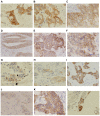Biomarker Analyses in Patients With Advanced Solid Tumors Treated With the LAT1 Inhibitor JPH203
- PMID: 32871789
- PMCID: PMC7652516
- DOI: 10.21873/invivo.12077
Biomarker Analyses in Patients With Advanced Solid Tumors Treated With the LAT1 Inhibitor JPH203
Abstract
Background/aim: Amino acids are among the most important nutrients for supplying energy and building protein blocks in cancers. L-type amino acid transporter (LAT) 1 is known to play a critical role in cancer growth. We have completed the first-in-human phase I study using the LAT1-specific inhibitor JPH203.
Patients and methods: We evaluated plasma free amino acids (PFAAs), body mass index (BMI), and efficacy of JPH203 in patients enrolled in the phase I study.
Results: LAT1-substrate PFAAs and branched chain amino acids (BCAAs) were higher in patients with biliary tract cancer (BTC) than in those with other cancers. High inhibition of uptake of LAT1-substrate PFAAs was associated with survival. BMI of more than the median was associated with disease control and survival. BCAAs tended to be associated with BMI.
Conclusion: BCAAs and BMI are useful predictors of the efficacy of JPH203, which shows promising activity against BTC.
Keywords: JPH203; L-type amino acid transporter; amino acids; biliary tract cancer; body mass index.
Copyright© 2020, International Institute of Anticancer Research (Dr. George J. Delinasios), All rights reserved.
Conflict of interest statement
Okano N. received personal fee from J-Pharma. Hana K. received salary from J-Pharma. Endou H. received salary from J-Pharma, and has pending patents for LAT1, JPH203, and application of JPH203 in Phase I study of solid tumors. Furuse J. received grant and personal fee from J-Pharma. The other Authors declare that they have no conflicts of interest.
Figures








References
-
- Yanagida O, Kanai Y, Chairoungdua A, Kim DK, Segawa H, Nii T, Cha SH, Matsuo H, Fukushima JI, Fukasawa Y, Tani Y. Human L-type amino acid transporter 1 (LAT1): characterization of function and expression in tumor cell lines. Biochim Biophys Acta. 2001;1514(2):291–302. doi: 10.1016/S0005-2736(01)00384-4. - DOI - PubMed
Publication types
MeSH terms
Substances
LinkOut - more resources
Full Text Sources
Medical
Research Materials
